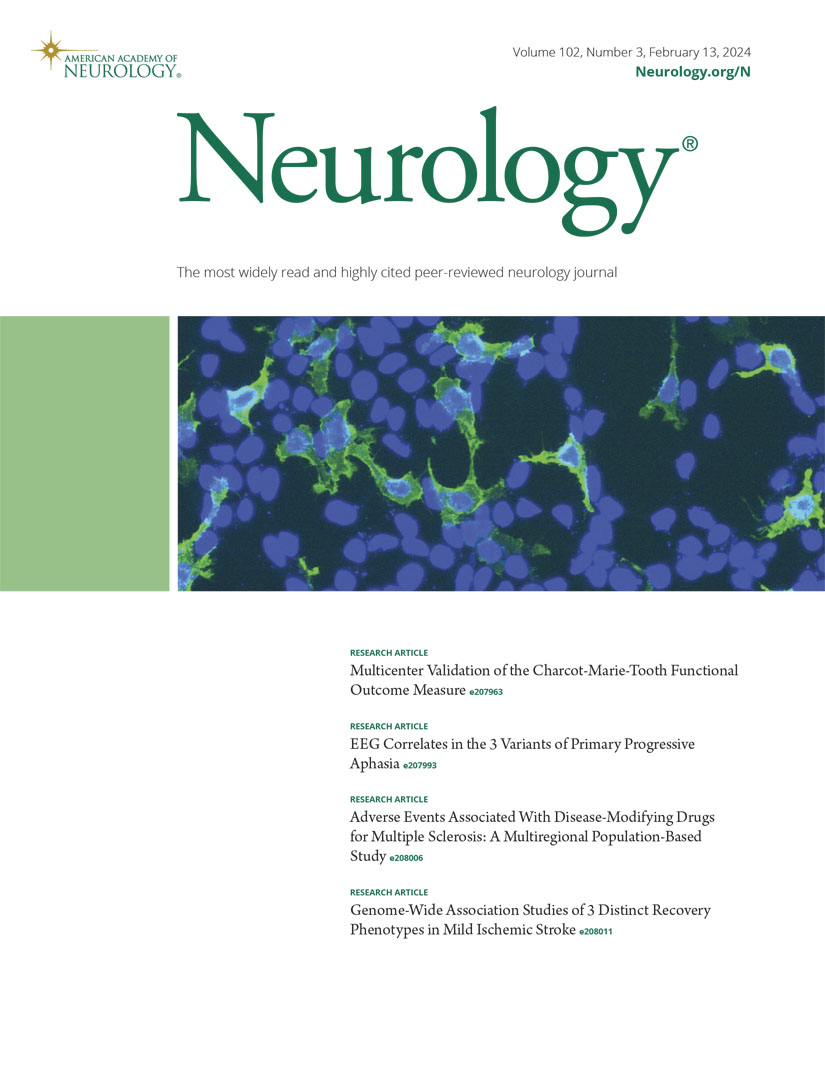早期阿尔茨海默病中磷酸化Tau蛋白水平变化与认知障碍严重程度之间的关系
IF 7.7
1区 医学
Q1 CLINICAL NEUROLOGY
引用次数: 0
摘要
背景与目的将早期阿尔茨海默病(AD)的生物标志物证据与临床表现相结合,对于改善诊断、预后和干预措施至关重要。本研究评估了痴呆前期AD患者的认知障碍、未来衰退和血浆和脑脊液中磷酸化tau水平之间的关系。方法:这项纵向观察性研究包括来自2个独立队列的痴呆前期病例和对照组:挪威痴呆病启动(DDI)和加拿大阿尔茨海默病实验性或新型治疗的症状前评估(prevention - ad)。在DDI中,认知正常(CN)和轻度认知障碍(MCI)病例使用CSF A - β42/40比值(A)和p-tau181 (T)进行分类,而prevention - ad (A)的分类基于淀粉样蛋白PET扫描。在DDI中,我们评估了p-tau181、p-tau217和p-tau231在csf -血浆中的相关性。通过对受者工作特征的分析来评估诊断的准确性。线性混合模型评估了p-tau与未来记忆衰退的关联。评估两组患者血浆p-tau217的组间差异。结果DDI (n = 431)患者分为CN A-/T- (n = 169)、A+/T- (CN = 26, MCI = 24)、A+/T+ (CN = 40, MCI = 105)、A-/T+ (CN = 34, MCI = 33),平均年龄64.1岁,女性55.9%。在prevention - ad (n = 190)中,参与者分为CN A- (n = 118)、CN A+ (n = 49)和MCI A+ (n = 21),平均年龄为67.8岁,其中72.6%为女性。在DDI中,血浆p-tau217在识别A+参与者方面具有很高的准确性(曲线下面积[AUC]: 0.85),并且与CSF p-tau217具有中等相关性(rho = 0.65, p < 0.001)。血浆p-tau217在MCI A+中的诊断准确率(AUC: 0.89)高于CN A+ (AUC: 0.79, p < 0.05), A+/T+ (AUC: 0.88)高于A+/T- (AUC: 0.78, p < 0.05)。在A+个体中,p- tau181和p-tau231与csf -血浆的相关性较弱(rho = 0.47和rho = 0.32, p < 0.001),与认知状态的相关性较小。A+ MCI与A+ CN个体的血浆p-tau217较高(p < 0.001)在prevention - ad中得到证实。除血浆p-tau217外,所有脑脊液p-tau标志物均与未来记忆衰退相关(β = 0.05, p < 0.05)。我们的研究结果表明,与p-tau181和p-tau231不同,血浆p-tau217与A+个体的认知状态一致,更好地反映脑脊液生物标志物异常,减少了临床和生化结果之间的差异。它与基线和未来记忆衰退的关联突出了它的诊断和预后价值,特别是当脑脊液分析或PET不可用时。本文章由计算机程序翻译,如有差异,请以英文原文为准。
Associations Between Changes in Levels of Phosphorylated Tau and Severity of Cognitive Impairment in Early Alzheimer Disease.
BACKGROUND AND OBJECTIVES
Aligning biomarker evidence with clinical presentation in early Alzheimer disease (AD) is essential for improving diagnosis, prognosis, and interventions. This study evaluates the relationship between cognitive impairment, future decline, and phosphorylated tau levels in plasma and CSF in predementia AD.
METHODS
This longitudinal observational study included predementia cases and controls from 2 independent cohorts: the Norwegian Dementia Disease Initiation (DDI) and Canadian Pre-Symptomatic Evaluation of Experimental or Novel Treatments for Alzheimer's Disease (PREVENT-AD). In DDI, cognitively normal (CN) and mild cognitive impairment (MCI) cases were classified using CSF Aβ42/40 ratio (A) and p-tau181 (T), whereas classification in PREVENT-AD (A) was based on amyloid PET scans. In DDI, we assessed CSF-plasma correlations for p-tau181, p-tau217, and p-tau231. Diagnostic accuracies were evaluated through receiver operating characteristic analyses. Linear mixed models evaluated p-tau associations with future memory decline. Between-group differences in plasma p-tau217 were assessed in both cohorts.
RESULTS
In DDI (n = 431), participants were classified as CN A-/T- (n = 169), A+/T- (CN = 26, MCI = 24), A+/T+ (CN = 40, MCI = 105), and A-/T+ (CN = 34, MCI = 33), with a mean age of 64.1 years and 55.9% female. In PREVENT-AD (n = 190), participants were categorized as CN A- (n = 118), CN A+ (n = 49), and MCI A+ (n = 21), with a mean age of 67.8 years and 72.6% female. In DDI, plasma p-tau217 showed high accuracy in identifying A+ participants (areas under the curve [AUC]: 0.85) and a moderate correlation with CSF p-tau217 (rho = 0.65, p < 0.001). Diagnostic accuracy of plasma p-tau217 was greater in MCI A+ (AUC: 0.89) than in CN A+ (AUC: 0.79, p < 0.05) and in A+/T+ (AUC: 0.88) vs A+/T- (AUC: 0.78, p < 0.05). p-Tau181 and p-tau231 had weaker CSF-plasma correlations (rho = 0.47 and rho = 0.32, p < 0.001) and were less associated with cognitive status in A+ individuals. Higher plasma p-tau217 in A+ MCI vs A+ CN individuals (p < 0.001) was confirmed in PREVENT-AD. All CSF p-tau markers, but only plasma p-tau217, were associated with future memory decline (β = 0.05, p < 0.05).
DISCUSSION
Our findings suggest that, unlike p-tau181 and p-tau231, plasma p-tau217 consistently aligns with cognitive status in A+ individuals and better reflects CSF biomarker abnormalities, reducing discrepancies between clinical and biochemical findings. Its association with baseline and future memory decline highlights its diagnostic and prognostic value, particularly when CSF analysis or PET is unavailable.
求助全文
通过发布文献求助,成功后即可免费获取论文全文。
去求助
来源期刊

Neurology
医学-临床神经学
CiteScore
12.20
自引率
4.00%
发文量
1973
审稿时长
2-3 weeks
期刊介绍:
Neurology, the official journal of the American Academy of Neurology, aspires to be the premier peer-reviewed journal for clinical neurology research. Its mission is to publish exceptional peer-reviewed original research articles, editorials, and reviews to improve patient care, education, clinical research, and professionalism in neurology.
As the leading clinical neurology journal worldwide, Neurology targets physicians specializing in nervous system diseases and conditions. It aims to advance the field by presenting new basic and clinical research that influences neurological practice. The journal is a leading source of cutting-edge, peer-reviewed information for the neurology community worldwide. Editorial content includes Research, Clinical/Scientific Notes, Views, Historical Neurology, NeuroImages, Humanities, Letters, and position papers from the American Academy of Neurology. The online version is considered the definitive version, encompassing all available content.
Neurology is indexed in prestigious databases such as MEDLINE/PubMed, Embase, Scopus, Biological Abstracts®, PsycINFO®, Current Contents®, Web of Science®, CrossRef, and Google Scholar.
 求助内容:
求助内容: 应助结果提醒方式:
应助结果提醒方式:


